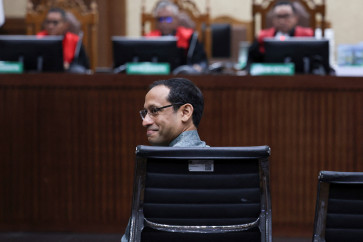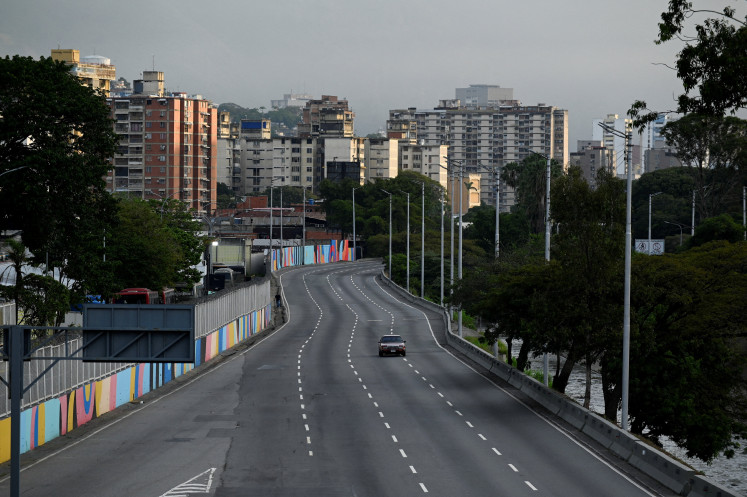Popular Reads
Top Results
Can't find what you're looking for?
View all search resultsPopular Reads
Top Results
Can't find what you're looking for?
View all search resultsThe best way to stem flooding
February is the month when rainfall in Jakarta and other areas in Indonesia is at its highest and floods become a threat for residents
Change text size
Gift Premium Articles
to Anyone
February is the month when rainfall in Jakarta and other areas in Indonesia is at its highest and floods become a threat for residents. Fortunately, the extent of this year’s flooding was not as great as in the last two years.
In February 2007, the worst flooding in Jakarta's history inundated about 70 percent of the city, killed at least 57 people and forced about 450,000 to flee their homes. In February 2008, 37 of Jakarta's 267 subdistricts were inundated by more than 40 centimeters of water. Floodwaters forced public transportation, including the busway lines across Jakarta, to a halt, leaving thousands of passengers stranded. Last year's flooding also inundated the Sedyatmo toll road to Soekarno-Hatta International Airport, cutting off the highway for a days. Nearly 1,000 flights were delayed or diverted and 259 flights were canceled.
Interestingly, the level of rainfall in Jakarta this year has been higher than in 2008 and is about the same as in 2007. With 339 millimeters, February 2, 2009 saw the highest amount of rainfall so far this year. This was rainfall is slightly higher than 2007's wettest day (317 millimeters) and much higher than 2008's (117 millimeters). It is important to note that the high amount of rainfall in the Jakarta's neighboring areas has also been blamed for the major floods of 2007.*
In response to the last year's flooding, Governor Fauzi Bowo put in palce several strategic measures, including ensuring the effectiveness of early warning systems, dredging the river to enable water to flow properly, reinforcing the Pluit, Sunter and Riario dams and placing mobile water pumps on the Sedyatmo toll roads to prevent blackouts.
The relative mildness of this year's floods is in part a result of the effectiveness of these measures. Such measures may be able to mitigate the impact of this year's flooding, but still cannot prevent the flooding entirely.
Jakarta has 18 main canals and 500 smaller canals of two to 15 meters in diameter. Jakarta's network of canals worked at just 50 to 70 percent of their capacity because these canals are clogged by 9 million cubic meters of sediment and garbage (The Jakarta Post, February 2, 2009). Furthermore, Budi Widiantoro of the Jakarta Public Works Agency blamed the garbage as the main cause of the low capacity of Jakarta's canals (The Jakarta Post, Jan. 14, 2009). Educating residents of the importance of not throwing garbage into canals is certainly a big challenge for the Jakarta administration. Dredging canals will not be effective if people continue to throw garbage into canals.
In the aftermath of the major floods in 2002, the central government and the Jakarta administration launched the East Flood Canal project. The project is aimed at reducing floods in a 270-square-kilometer flood-prone area of East and North Jakarta, but it has progressed very slowly. As of February 2009, the Jakarta administration has procured only 62 percent of the needed land. The East Flood Canal is believed to be most feasible solution for preventing future flooding in Jakarta, but apparently it will not be easy to complete the East Flood Canal project.
Neither dredging the canals and rivers nor building new canals is a sustainable solution for preventing future flooding in Jakarta. As the economic, commercial, cultural and transportation hub of the nation, Jakarta is poised to grow faster than other parts of Indonesia. The annual floods are strong evidence that Jakarta cannot sustainably accommodate its rapid growth.
Indonesia needs to redistribute the central functions of Jakarta to other parts of the nation and create more urban agglomerations to pull urban growth away from Jakarta. Relocating central functions out of Jakarta will reduce the rapid growth in Jakarta and provide a sustainable solution for preventing future flooding in Jakarta.
The writer is an assistant professor and coordinator of urban studies and planning at Savannah State University, GA, USA. *










